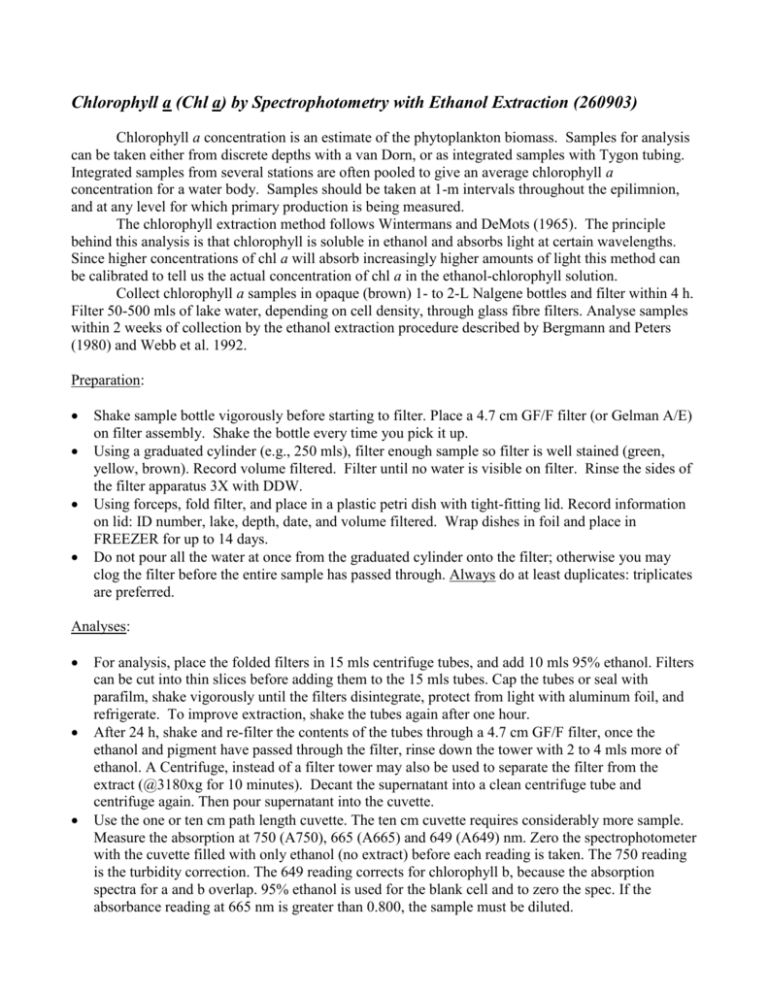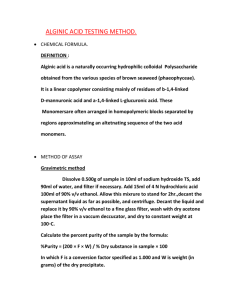Chlorophyll a (Chl a)
advertisement

Chlorophyll a (Chl a) by Spectrophotometry with Ethanol Extraction (260903) Chlorophyll a concentration is an estimate of the phytoplankton biomass. Samples for analysis can be taken either from discrete depths with a van Dorn, or as integrated samples with Tygon tubing. Integrated samples from several stations are often pooled to give an average chlorophyll a concentration for a water body. Samples should be taken at 1-m intervals throughout the epilimnion, and at any level for which primary production is being measured. The chlorophyll extraction method follows Wintermans and DeMots (1965). The principle behind this analysis is that chlorophyll is soluble in ethanol and absorbs light at certain wavelengths. Since higher concentrations of chl a will absorb increasingly higher amounts of light this method can be calibrated to tell us the actual concentration of chl a in the ethanol-chlorophyll solution. Collect chlorophyll a samples in opaque (brown) 1- to 2-L Nalgene bottles and filter within 4 h. Filter 50-500 mls of lake water, depending on cell density, through glass fibre filters. Analyse samples within 2 weeks of collection by the ethanol extraction procedure described by Bergmann and Peters (1980) and Webb et al. 1992. Preparation: Shake sample bottle vigorously before starting to filter. Place a 4.7 cm GF/F filter (or Gelman A/E) on filter assembly. Shake the bottle every time you pick it up. Using a graduated cylinder (e.g., 250 mls), filter enough sample so filter is well stained (green, yellow, brown). Record volume filtered. Filter until no water is visible on filter. Rinse the sides of the filter apparatus 3X with DDW. Using forceps, fold filter, and place in a plastic petri dish with tight-fitting lid. Record information on lid: ID number, lake, depth, date, and volume filtered. Wrap dishes in foil and place in FREEZER for up to 14 days. Do not pour all the water at once from the graduated cylinder onto the filter; otherwise you may clog the filter before the entire sample has passed through. Always do at least duplicates: triplicates are preferred. Analyses: For analysis, place the folded filters in 15 mls centrifuge tubes, and add 10 mls 95% ethanol. Filters can be cut into thin slices before adding them to the 15 mls tubes. Cap the tubes or seal with parafilm, shake vigorously until the filters disintegrate, protect from light with aluminum foil, and refrigerate. To improve extraction, shake the tubes again after one hour. After 24 h, shake and re-filter the contents of the tubes through a 4.7 cm GF/F filter, once the ethanol and pigment have passed through the filter, rinse down the tower with 2 to 4 mls more of ethanol. A Centrifuge, instead of a filter tower may also be used to separate the filter from the extract (@3180xg for 10 minutes). Decant the supernatant into a clean centrifuge tube and centrifuge again. Then pour supernatant into the cuvette. Use the one or ten cm path length cuvette. The ten cm cuvette requires considerably more sample. Measure the absorption at 750 (A750), 665 (A665) and 649 (A649) nm. Zero the spectrophotometer with the cuvette filled with only ethanol (no extract) before each reading is taken. The 750 reading is the turbidity correction. The 649 reading corrects for chlorophyll b, because the absorption spectra for a and b overlap. 95% ethanol is used for the blank cell and to zero the spec. If the absorbance reading at 665 nm is greater than 0.800, the sample must be diluted. Calculation: (13.7( A665 A750) 5.76( A649 A750))v V *l v = volume(ml) of extract V = volume (L.) of sample filtered l = pathlength of spectrophotometer cuvette, in cm Chl a (g/L) = Tubes used for analysis should be rinsed with DDW and immersed in the soap bath. Phaeopigments Analyses (not performed in Bio 412) After reading samples for chlorophyll, add 30 L 2N HCl to 10 mls sample, and shake well. pH should be 2.4 to 2.6. Re-read samples between 5 to 30 minutes later. Calculations: (after Nusch) Chl a (g/L)= (A665-A750b)-(A665-A750a)(R/R-1)(v/V*1)(103)/ Where, Chl a = chlorophyll a corrected for phaeophytin content 665-750 b = before acidification 665-750 a = after acidification R/R-1 = 1.7/0.7 and is the acid ratio for pure chlorophyll a = specific absorption coefficient for chlorophyll a (g*L-1*cm-1) V = volume of water filtered, in L v = volume of solvent used to extract sample, in mls l = pathlength of spectrophotometer cuvette, in cm Equation simplifies to: 29.6 (665 b-665 a)( v / V * l) Phaeophytin may then be calculated as: (g/L)= 20.8 (665 a (v / V * l) - Chl a (g/L) References: Bergmann, M. and R. H. Peters. 1980. A simple reflectance method for the measurement of particulate pigment in lake water and its application to Phosphorus-Chlorophyll-Seston Relationships. Can. J. Fish. Aquat. Sci. 37:111-114. Webb, D.J., B.K. Burnison, A.M. Trimbee, and E. E. Prepas. Comparison of chlorophyll a extractions with ethanol and dimethyl sulfoxide/acetone, and a concern about spectrophotometric phaeopigment correction. Can. J. Fish. Aquat. Sci. 49:2331-2336. Wintermans, J. F. G. M. and A. DeMots. 1965. Spectrophotometric characteristics of chlorophyll 'a' and 'b' and their pheophytins in ethanol. Biochimica et Biophysica Acta 109: 448-453. Nusch, E. A. 1980. Comparison of different methods for chlorophyll and phaeopigment determination. Arch. Hydrobiol. Beih. Ergebn. Limnol. 14: 14-36.









